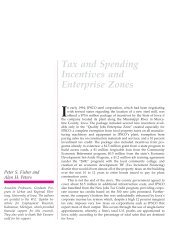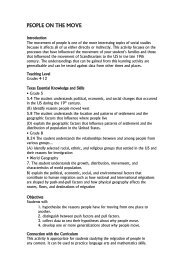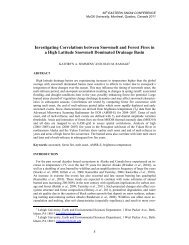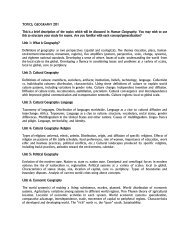Texas Social Studies Framework - Department of Geography ...
Texas Social Studies Framework - Department of Geography ...
Texas Social Studies Framework - Department of Geography ...
You also want an ePaper? Increase the reach of your titles
YUMPU automatically turns print PDFs into web optimized ePapers that Google loves.
88<br />
88<br />
The four walls <strong>of</strong> the classroom just expanded! The<br />
Internet now makes it possible to visit museums all over<br />
the world via the classroom computer.<br />
• Take a virtual tour <strong>of</strong> the Louvre in Paris ().<br />
• Explore Egyptian treasures in the Metropolitan<br />
Museum <strong>of</strong> Art in New York City ().<br />
• Learn about the experiences <strong>of</strong> the earliest<br />
permanent English settlers in North America at<br />
Jamestown, Virginia ()<br />
and Plymouth, Massachusetts ().<br />
In addition, the Internet <strong>of</strong>fers the unique opportunity for<br />
students to take part in museum educational <strong>of</strong>ferings<br />
without leaving the classroom. Many museums are<br />
developing online educational resources.<br />
• The Institute <strong>of</strong> Texan Cultures has interactive<br />
programs featuring the Alamo and Tejano<br />
ranching ().<br />
• Mystic Seaport Museum maintains a virtual site<br />
where students can learn more about the experiences<br />
<strong>of</strong> Africans aboard the slave ship Amistad,<br />
their rebellion, and subsequent Supreme Court<br />
decision on their future as humans or property<br />
().<br />
• Visit the virtual exhibits and the digital classroom<br />
<strong>of</strong>fered by the National Archives and<br />
Records Administration in Washington, D.C.<br />
().<br />
7) A successful museum trip involves the “Three P’s”:<br />
preparation, participation, and post-visit reflection.<br />
Preparation. Museums can be overwhelming. Students<br />
who receive information on the experience before the<br />
visit, know where they are going, and know what they<br />
will see and do tend to gain more from the experience.<br />
The best school visits result from preparation.<br />
• Most museums have pre-visit packets <strong>of</strong> information<br />
that include brochures with pictures <strong>of</strong><br />
the site, information about the museum and its<br />
collections, and activities to complete as a class<br />
before a visit.<br />
• Visit the museum website if they have one and<br />
discuss the route, the location, and the rules <strong>of</strong><br />
Chapter 8: Implementing the TEKS: Other Players<br />
behavior. Let the students help map and plan the<br />
trip.<br />
• Museums cannot exist without artifacts. They<br />
must preserve them and make them available to<br />
the general visitor. Explain this to the students so<br />
they understand that the things they will see<br />
provide a direct link to another time and to the<br />
activities and ideas <strong>of</strong> other people. This makes it<br />
easier for students to understand the things<br />
museum staff ask them to do during the visit.<br />
Teachers should know what they want to accomplish<br />
beforehand and they should select the program most<br />
appropriate for their class, whether presented in the form<br />
<strong>of</strong> a site visit, virtual exhibit on the Internet, or a curriculum<br />
product. See and do less and leave students asking<br />
for more. Encourage family trips if students want to see<br />
more.<br />
Participation. What will students learn in a museum? To<br />
really learn, students must be actively engaged in some<br />
kind <strong>of</strong> directed learning experience. Think <strong>of</strong> this as<br />
fieldWORK, not as a fieldTRIP. Students should have the<br />
opportunity to use a variety <strong>of</strong> social studies skills, from<br />
critical thinking and observation to sketching and<br />
distinguishing between primary and secondary resources.<br />
Here are some suggested student activities:<br />
• Students can write stories <strong>of</strong> the individuals and<br />
lifestyles about which they learned.<br />
• Students can draw maps and compute the miles<br />
traveled to the museum.<br />
• They can consider the economic characteristics<br />
<strong>of</strong> the museum, its sources <strong>of</strong> funding and<br />
support, and the role <strong>of</strong> government in the future<br />
<strong>of</strong> the museum.<br />
• Students can consider issues <strong>of</strong> citizenship and<br />
the role museums play in preserving the customs,<br />
symbols, and celebrations <strong>of</strong> the past.<br />
• Students can gain a greater understanding <strong>of</strong><br />
their role in the perpetuation <strong>of</strong> museums in<br />
<strong>Texas</strong>. They can serve as responsible citizens and<br />
effective leaders by encouraging support for<br />
museum funding, or volunteering their time to<br />
the institutions.<br />
Here is a generic participation strategy:<br />
Observing artifacts in a collection helps students<br />
understand the differences between primary and
















